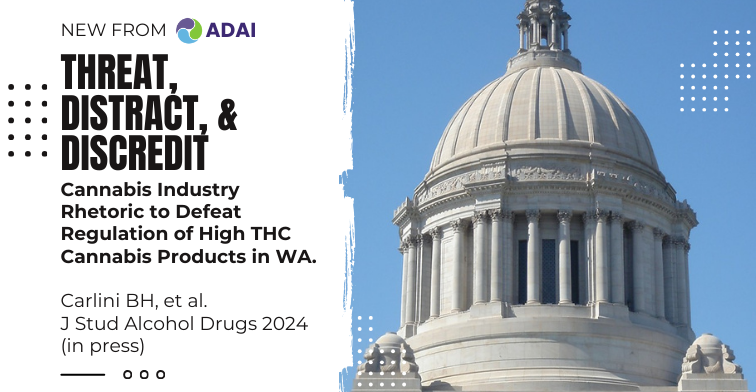New from ADAI: Threaten, Distract, and Discredit: Cannabis Industry Rhetoric to Defeat Regulation of High THC Cannabis Products in WA
02/05/2024Citation: Carlini BH, Kellum LB, Garrett SB, Nims LN. Threaten, distract, and discredit: Cannabis industry rhetoric to defeat regulation of high THC cannabis products in Washington State, USA. Journal of Studies on Alcohol and Drugs 2024 (in press). doi: 10.15288/jsad.23-00277

Cannabis industry actors have adopted several arguments used by alcohol, pharmaceutical, food, and tobacco industry actors to undermine initiatives to advance public health in Washington State, according to this new paper from ADAI’s Cannabis Education and Research Program (CERP), led by director and first-author Beatriz Carlini, PhD, MPH.
The team analyzed 41 testimonies transcribed from 33 cannabis industry actors in 3 public bill hearings and one legislative work session that occurred between 2020 and 2023 and found three main strategies employed across the industry:
Threaten: Cannabis industry actors argued that regulating THC content (through caps or taxes, e.g.) was a threat to the economy, people’s health and safety, or the will of the people, by equating regulation to cannabis prohibition, a policy rejected by popular vote in Washington State.
Distract: They would bring forward issues only tangentially related to the bills in an attempt to change focus. For example, they’d emphasize how compliant with rules the cannabis industry has been, suggest non-policy solutions like education or better enforcement, or express concern with a different topic, like lack of regulation of hemp-derived cannabis products that existed outside the regulated market at the time of the testimonies.
Discredit: Finally, cannabis industry actors would question the validity of the research or people who presented research by challenging methodology, design, and/or results, or denouncing public health and other professionals as biased and untrustworthy.
Spreading fear and apprehension, the narratives put forth by cannabis industry actors have been effective with some stakeholders and policymakers, even when those narratives have not been supported by science.
This is the first study to analyze the rhetoric of the cannabis industry in the legislative setting. A better understanding of the industry’s rhetoric can be used by public health advocates and policy makers to develop evidence-based counterarguments and disseminate alternative narratives that can protect the public’s health.
(Need help getting a copy? Contact ADAI librarian Meg Brunner: meganw@uw.edu)





